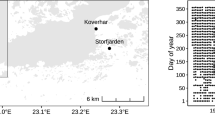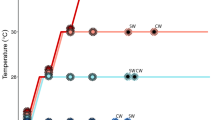Summary
Primary productivity in Lancaster Sound was estimated from chlorophyll and light irradiance profiles and light saturation measurments. Mesozooplankton concentrations were measured using an in situ zooplankton counter mounted on a Batfish and with the BIONESS. Microzooplankton concentrations were estimated from samples taken with the BIONESS. The horizontal and vertical distribution of the two groups of zooplankton are described and related to the distribution of chlorophyll primary production and physical features of the Sound. A westward intrusion of Baffin Bay water along the north shore of the sound which mixed with Arctic water flowing easterly resulted in a complex physical environment in the sound. The admixing of these water masses resulted in a highly variable biological structure. The thermocline was the main physical feature that affected the depth of the chlorophyll layer and the levels of primary production, with a shallow thermocline resulting in higher primary production. The admixing of Baffin Bay water with Arctic water at different areas of the sound combined with the different times of appearance of open water resulted in the populations of Calanus hyperboreus and C. glacialis showing different age structures, the youngest being in the Arctic water at the western end of the Sound. Microzooplankton populations were concentrated at various depths depending on the species. Oithona juveniles preferred the upper 10 m when the thermocline was near the surface. Most macrozooplankton were found below the thermocline and the primary production maxium. The largest concentrations of microzooplankton were found at the western end of the Sound in the Arctic water believed to be still in the biological spring.
Similar content being viewed by others
References
Buchanan RA, Sekerak AD (1982) Vertical distribution of zooplankton in eastern Lancaster Sound and western Baffin Bay, July October 1978. Arctic 35:41–55
Dessureault JG (1976) ‘Batfish’: a depth controllable towed body for collecting oceanographic data. Ocean Eng 3:99–111
Grainger EH (1963) Copepods of the genus Calanus as indicators of eastern Canadian waters. In: Dunbar MJ (ed) Marine distributions. R Soc Can, Spec Publ No 5, pp 68–94
Harrison WG, Platt T, Lewis MR (1985) The utility of light saturation models for estimating marine primary productivity in the field: a comparison with conventional “simulated” in situ methods. Can J Fish Aquat Sci 42:864–872
Herman AW (1983) Vertical distribution patterns of copepods in northeastern Baffin Bay. Limnol Oceanogr 28:707–719
Herman AW, Denman KL (1977) Rapid underway profiling of chlorophyll with an in situ fluorometer mounted on a Batfish vehicle. Deep-Sea Res 24:385–397
Herman AW, Dauphinee TM (1980) Continuous and rapid profiling of zooplankton tow with an electronic counter mounted on a ‘Batfish’ vehicle. Deep-Sea Res 27:79–96
Herman AW, Mitchell MR (1981) Counting and identifying copepod species with an situ electronic zooplankton counter. Deep-Sea Res 28:739–755
Herman AW, Platt T (1983) Numerical modelling of diel carbon production and zooplankton grazing on the Scotian Shelf based on observational data. Ecol Modelling 18:55–72
Herman AW, Platt T (1986) Primary production profiles in the Ocean: estimation from chlorophyll/light model. Ocean Acta (in press)
Irwin B, Lindley P, Harrison WG, Platt T (1983) Phytoplankton productivity in the Eastern Canadian Arctic during July and August 1980. Can Data Rep Fish Aquat Sci 386:1–157
Longhurst AR, Williams R (1979) Materials for plankton modelling: vertical distribution of Atlantic zooplankton in summer. J Plankton Res 1:1–28
Longhurst A, Sameoto D, Herman A (1984) Vertical distribution of Arctic zooplankton in summer: eastern Canadian archipelago. J Plankton Res 6:137–168
Milne AR, Smiley BD (1978) Offshore drilling in Lancaster Sound. Possible environment hazards. Inst Ocean Sci, Patricia Bay Dept, Fish and Environ, 95 pp
Sameoto DD, Jaroszynski, Fraser WB (1980) BIONESS, a new design in multiple net zooplankton samplers. Can J Fish Aquat Sci 37:722–724
Sameoto DD (1984a) Vertical distribution of zooplankton biomass and species in northeastern Baffin Bay related to temperature and salinity. Polar Biol 2:213–224
Sameoto DD (1984b) Environmental factors influencing diurnal distribution of zooplankton and ichthyoplankton. J Plankton Res 6:767–792
Sekerak AD, Thomson D, Bain H, Acreman J (1976) ‘Summer surveys of the marine ecology of Creswell Bay, Smerset Island and Assistance Bay, Cornwallis Island, NWT’. Unpublished report by LGL, for Polar Gas Ltd, pp 251 (available at Bedford Institute)
Author information
Authors and Affiliations
Rights and permissions
About this article
Cite this article
Sameoto, D., Herman, A. & Longhurst, A. Relations between the thermocline meso and microzooplankton, chlorophyll a and primary production distributions in Lancaster Sound. Polar Biol 6, 53–61 (1986). https://doi.org/10.1007/BF00446241
Received:
Accepted:
Issue Date:
DOI: https://doi.org/10.1007/BF00446241




